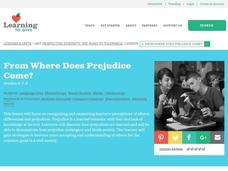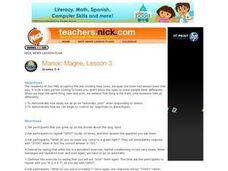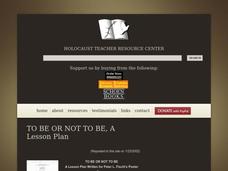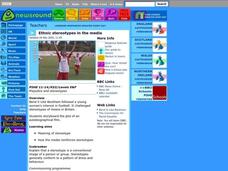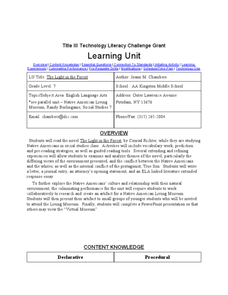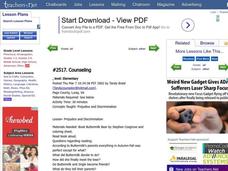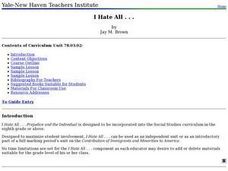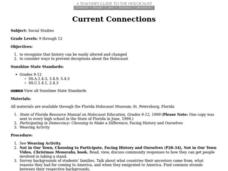Curated OER
Those Who Don't Know: Identity, Membership, and Stereotypes
Students explore their identities. In this social studies instructional activity, students examine stereotyping and discuss factors that define their personal identities. Students compare their stories to the story of Esperanza in the...
Curated OER
I Belong, But Why Don't You?
Students explore discrimination. In this character development instructional activity, students identify groups and organizations to which they belong and the requirements that go with each group. Students discuss inclusion and exclusion...
Curated OER
Investigating Respect
Middle schoolers examine prejudice and stereotyping. In this prejudice and stereotyping lesson, students define the words and give examples. They look at pictures of five different people before working in groups to discover their own...
Curated OER
You've Got to be Taught to Hate and Fear
Students explore themes of prejudice and acceptance. In this character education lesson, students listen and respond to several fiction books, poems, and lyrics with a similar theme. Students locate articles with the main idea of...
Curated OER
Famous African Americans Mini book
Students discuss the achievements of famous African Americans. In this African American history month lesson, students discuss the origins of African American history month. They define prejudice and the obstacles that many African...
Curated OER
From Where Does Prejudice Come?
Students explore the concept of discrimination. In this social studies lesson, students view pictures and write down the first thing that comes to their mind. Students discuss if stereotyping or prejudice affected their first...
Curated OER
Defining Respect
Students examine what respect is and isn't. In this character education lesson, students create a t-chart of what respect looks like and doesn't look like. The teacher adds the words bias, prejudice, stereotype and racism to the chart....
Curated OER
Maniac McGee, Lesson 3
Students explore possible causes of stereotyping. In this multicultural awareness instructional activity, students participate in activities in which "conditioning" affects responses. Students compare their conditioned responses to...
Curated OER
Everything You Know Is Wrong 1: Us and Them
High schoolers explore rational, irrational, analytical and non-analytical methods of reasoning. They participate in numerous exercises and hands-on activities to understand assumptions and how most people think. Students establish the...
Curated OER
To Be Or Not To Be
Students read the poem "To the Little Polish Boy Standing With His Arms Up." They discuss the poem. Students define the term "prejudice." They comapre and contrast the boy in the poster with the author of the poem, Peter Fischl. ...
Curated OER
Focus on the Media
Students critically examine news articles and editorials for attitudes of discrimination and prejudice. Students then complete checklist in which they analyze news reports for context, content, point of view, language, graphics, and...
Curated OER
Ethnic Stereotypes in the Media
High schoolers examine the existence of stereotypes and how various forms of media help to reinforce them. Groups discuss common stereotypes on a list of popular television shows. Student groups design a storyboard for an...
Curated OER
First Impressions
Students explore first impressions. They examine that many of the first impressions are based on one's outward appearance, such as body or shape. Students explore that these first impressions can be very misleading. They practice skills...
Curated OER
Social Reformation-Irish Immigration in the 1800s
Students discuss the causes of the influx of Irish immigrants between 1800 and 1875. They focus on what immigrants' lives were like in the United States and what impact the move across the Atlantic had on thier families. They complete a...
Curated OER
We're All The Same on the Inside
Students discuss prejudice around the Martin Luther King, Jr. holiday. They use brown and white eggs to discover that they are both the same on the inside even though they look different on the outside.
Curated OER
Nevada Native Plants and Animals
Fourth graders explore the Washoe people and their history among non-Washoe. The lesson focuses on not only the traditional, but also on the contemporary ways of life of the Washoe people. The unit consists of thirteen lessons.
Curated OER
Native American Culture: The Light in the Forest
Seventh graders read the novel, The Light in the Forest. They work in groups to research and create artifacts for a Native American Living Museum. They complete a Powerpoint presentation of their virtual museum to classmates.
Curated OER
Prejudice and Discrimination
As a group, students read a story about prejudice and discrimination. They answer questions and discuss the topic. They accept everyone.
Curated OER
Mr. Lincoln's Way
Students read the book, Mr. Lincoln's Way by Patricia Polacco, They discuss racism and discrimination. They draw a bird and write a paragraph discussing what makes their bird special and unique.
Curated OER
Bias, Prejudice and Propaganda
Twelfth graders examine bias, prejudeice, and propaganda in reading selections. They view commercials and print ads, discuss how the advertisers are trying to convince them of something, and keep a commercial journal.
Curated OER
Sneetches by Dr. Seuss
Students read "Sneetches" by Dr. Seuss. They complete a story map and write about the topic of prejudice. They role-play star-bellied and plain-bellied sneetches and write a persuasive essay about their experiences.
Curated OER
It Can't Happen Here or Can It?: Peer Pressure, Prejudice and Intolerance
Students study the Holocaust and explore peer pressure, prejudice and intolerance.
Curated OER
I Hate All . . .
Students examine the concept of prejudice of human beings towards other human beings. They define prejudice and analyze the history of the word, read a U.N. Commission Report on prejudice, and examine textbooks for prejudice.
Curated OER
Current Connections
Students recognize that history can be easily altered and changed, and consider ways to prevent deceptions about the Holocaust. They create class quilt that shows how to create harmony, understanding and tolerance of others.







